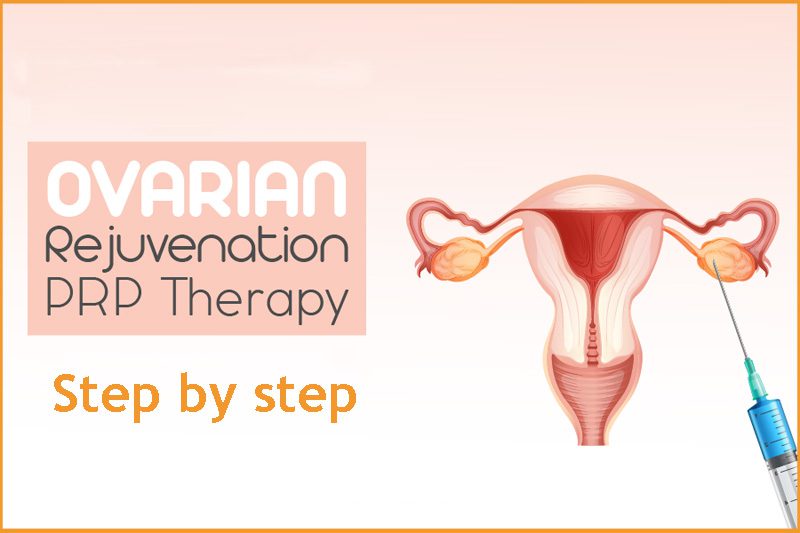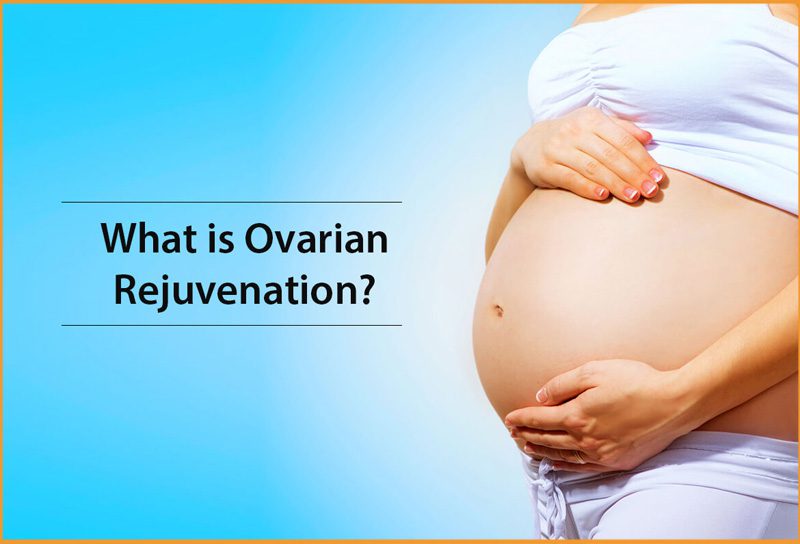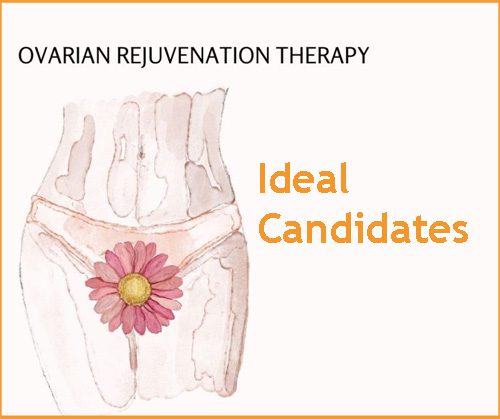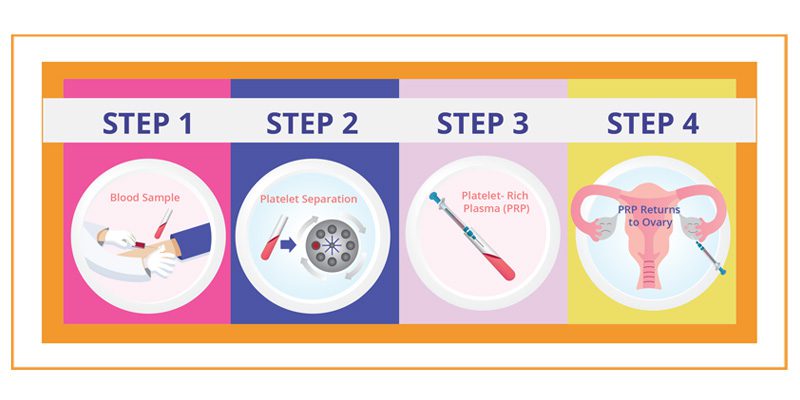Ovarian Rejuvenation Treatment with PRP (Platelet-rich plasma)

Ovarian rejuvenation is a medical procedure designed to restore or enhance the function of the ovaries in women. Ovarian Rejuvenation Treatment with PRP is specifically tailored for individuals grappling with fertility issues or experiencing early menopause, this innovative procedure employs techniques like ovarian tissue grafting and injection to stimulate the ovaries.
Ovarian rejuvenation is a groundbreaking medical procedure that holds promise for women facing diminished ovarian reserve or early menopause. In this comprehensive guide, we delve deep into the world of ovarian rejuvenation, shedding light on its purpose, recommended scenarios, differences from other treatments, life after the procedure, and what you can expect.
Ovarian rejuvenation, often referred to as “ovary rejuvenation,” is a cutting-edge medical procedure that harnesses the power of Platelet-Rich Plasma (PRP) to enhance ovarian function and fertility in women.
This innovative technique, known as “PRP ovarian rejuvenation” or “ovarian PRP,” involves the injection of concentrated platelet-rich plasma into the ovaries.
Get in touch for a Free Surrogacy Consultancy:
📲 +91-8800481100 ( WhatsApp, Line, Viber)
What is Ovarian Rejuvenation?
The process involves extracting a small piece of ovarian tissue, which houses immature eggs known as oocytes. These eggs are then carefully prepared and matured in a laboratory through hormonal medications.
Once mature, they can be harvested and used for various assisted reproductive techniques, including in vitro fertilization (IVF) or intracytoplasmic sperm injection (ICSI).
The primary goal of ovarian rejuvenation is to provide women with a renewed source of viable eggs, offering a potential solution to those with a diminished ovarian reserve or early menopause. Our experts are dedicated to helping women achieve their dreams of parenthood through this groundbreaking procedure.

What is the difference in the technique of Ovarian Regeneration?
There are 2 techniques by which you can receive the PRP treatment:
· Ovarian Injection Procedure
The procedure is performed by a skilled physician who utilizes a transvaginal approach to deliver Platelet-Rich Plasma (PRP) directly to the ovaries. The entire process typically takes approximately 15-20 minutes. Following the procedure, you will be taken to a dedicated recovery area, where our medical team will closely monitor your progress until you are ready for discharge, which typically occurs within about one (1) hour. For your safety, we strongly recommend having a companion accompany you on your journey home.
· Uterine Infusion Procedure
Uterine Infusion procedure is conveniently performed in an examination room and is offered as an outpatient treatment. During this procedure, you will be comfortably positioned in the dorsal-lithotomy position on the examination table. Our experienced healthcare provider will skillfully infuse Platelet-Rich Plasma (PRP) into the uterine cavity.
The entire Uterine Infusion procedure is completed in a swift 15 minutes, and there is no need for post-recovery care, allowing you to resume your daily activities with ease.
The Purpose of Ovarian Rejuvenation Techniques
The primary objective of Ovarian Rejuvenation is to enhance both the quality and quantity of a woman’s eggs. This not only holds the promise of improved fertility but may also serve to delay the onset of menopause and alleviate symptoms associated with ovarian aging. Importantly, this therapy is meticulously crafted to enable patients to conceive with their own eggs, preserving the essence of natural reproduction.
Why and When is Ovarian Rejuvenation Recommended?
Ovarian rejuvenation is recommended in specific situations where it can make a significant difference in a woman’s fertility journey. Here are some scenarios when it might be recommended:
- Diminished Ovarian Reserve: Women facing challenges due to a low number or poor quality of eggs may find it difficult to conceive naturally or through assisted reproductive techniques like IVF. Ovarian rejuvenation emerges as a promising option to increase the likelihood of a successful conception.
- Premature Ovarian Insufficiency: Early menopause, characterized by the cessation of menstrual periods before the age of 40, can be a distressing experience. Ovarian rejuvenation can stimulate the ovaries and potentially restore their function, offering renewed hope for conception.
- Fertility Preservation: For women who must undergo treatments that could potentially harm their ovaries, such as chemotherapy or radiation therapy for cancer, ovarian rejuvenation becomes a strategic choice. This procedure allows them to safeguard their ovarian tissue and immature eggs for future use, preserving their fertility even in the face of medical challenges.
Who is Ideal Candidates for Ovarian Rejuvenation Therapy
 Ovarian Rejuvenation therapy offers hope to women with reduced fertility due to age or specific conditions like premature ovarian insufficiency.
Ovarian Rejuvenation therapy offers hope to women with reduced fertility due to age or specific conditions like premature ovarian insufficiency.
While there is no strict age limit for this therapy, personal suitability is assessed on a case-by-case basis. Consulting with a fertility specialist is crucial, with this treatment option generally available to women up to the age of 45 to 47.
Ideal candidates for PRP are:
- Poor Response to IVF
- Low Ovarian Reserve (Low AMH)
- Poor Egg Quality
- Poor Egg Quantity
- Failed Embryo Transfer
- Thin Endometrial Lining
- Recurrent Implantation Failure
The Step-by-Step Journey of Ovarian Rejuvenation Therapy
Ovarian Rejuvenation is a carefully orchestrated process, which can be succinctly broken down into several pivotal phases:
1. Consultation & Evaluation
The journey begins with a comprehensive consultation and evaluation conducted by a fertility specialist. During this phase, your medical history is reviewed, and fertility goals are discussed. In some cases, diagnostic tests may be recommended to gain deeper insights into your unique situation.
2. Extraction
In Platelet-Rich Plasma (PRP) therapy, the procedure kicks off with the extraction of blood from the patient. This blood serves as the raw material for the preparation of Platelet-Rich Plasma (PRP). In contrast, stem cell therapy involves the extraction of stem cells from sources such as the patient’s bone marrow or adipose tissue, typically performed under anesthesia.
3. Preparation
In PRP therapy, the extracted blood undergoes a centrifugation process to separate platelets and plasma from other blood components. The result is PRP, a substance rich in growth factors that stimulate tissue regeneration. In stem cell therapy, the extracted stem cells are meticulously prepared for transplantation. In some cases, mechanical fragmentation of the ovarian cortex into smaller pieces may be employed.
4. Transplantation
For PRP therapy, the prepared PRP is injected directly into the ovaries. In the case of stem cell therapy, specialized laparoscopic surgery techniques are employed to ensure precise injection of stem cells into the ovary. The procedure may involve the extraction of theca stem cells, believed to be particularly beneficial for ovarian rejuvenation. It’s worth noting that research on the culture, growth, extraction, and multiplication of these stem cells is ongoing.
5. Post-Procedure Care
Following the procedure, patients undergo close monitoring to assess the treatment’s effectiveness and manage any potential side effects. Regular follow-ups are essential to track changes in menstrual patterns, hormone levels, and other indicators of improved ovarian function.
Success Rate of Stem Cell Therapy in Ovarian Rejuvenation
Determining the success rate of stem cell therapy for ovarian rejuvenation is a complex endeavor. Preliminary studies have shown promising results, suggesting a success rate of approximately 15 to 20%.
However, individual responses can vary significantly, underscoring the need for more comprehensive clinical trials to confirm its efficacy. Prospective patients are encouraged to engage in detailed discussions with a fertility specialist in Mumbai to explore the potential risks, costs, and benefits associated with this treatment.
How Does Ovarian Rejuvenation Differ from Other Treatment Options?

Ovarian rejuvenation stands out among fertility treatment options due to its unique focus on improving ovarian function directly. Here’s how it differs from other approaches:
- Ovarian Rejuvenation vs. Hormone Therapy: While hormone therapy, involving medications like estrogen or progesterone, is commonly used to manage menopause symptoms or regulate the menstrual cycle, it doesn’t address the root cause of decreased ovarian function. Ovarian rejuvenation, in contrast, aims to stimulate and potentially restore ovarian function through techniques like ovarian tissue grafting or injection.
- Ovarian Rejuvenation vs. Egg Donation: In cases where a woman’s ovaries no longer produce viable eggs, egg donation from a healthy donor is an option. However, ovarian rejuvenation centres on using a woman’s own ovarian tissue to stimulate the production of immature eggs, which can then be matured and used for assisted reproductive techniques.
- Ovarian Rejuvenation vs. IVF: In vitro fertilization (IVF) is a widely adopted assisted reproductive technique. It entails stimulating the ovaries with hormonal medications to produce multiple mature eggs, which are then retrieved and fertilized in a laboratory. Conversely, ovarian rejuvenation focuses on enhancing ovarian function itself by stimulating the ovaries and potentially obtaining immature eggs from ovarian tissue.
Life After Ovarian Rejuvenation
Life after ovarian rejuvenation is a journey filled with hope, possibilities, and considerations. Here are some aspects to contemplate:
- Fertility Improvement: Ovarian rejuvenation is geared toward enhancing ovarian function and increasing the chances of successful conception. Women who’ve faced diminished ovarian reserve or early menopause may find their fertility restored, boosting the odds of natural conception or successful assisted reproductive techniques like IVF.
- Pregnancy and Childbirth: The ultimate goal of ovarian rejuvenation is to facilitate pregnancy. In the event of conception post-procedure, women can experience pregnancy and childbirth just like any other expectant mother. It’s essential to remember that the success of pregnancy depends on various factors, including overall health, the partner’s fertility, and other factors affecting fertility.
- Ovarian Function: While ovarian rejuvenation aims to stimulate the ovaries and potentially restore their function, the extent to which it can provide long-term ovarian function and delay the onset of menopause is still under investigation. Realistic expectations and discussions with healthcare providers are essential.
- Emotional Well-being: Fertility treatments can be emotionally taxing. The anticipation and hope associated with ovarian rejuvenation may bring excitement and anxiety. Emotional support from loved ones, support groups, or mental health professionals can be invaluable during this journey.
- Additional Treatments: In certain cases, ovarian rejuvenation may be combined with other fertility treatments, such as IVF, to optimize the chances of successful conception. This could involve additional procedures and medications, impacting daily routines.
Navigating life after ovarian rejuvenation requires guidance and support. IVF Conceptions is dedicated to providing personalized information, addressing individual circumstances, setting realistic expectations, and offering unwavering support throughout the process.
Cost of Ovarian Rejuvenation
 Ovarian rejuvenation cost is in the range of $1800 to $20,00. However, varies from country to country and doctor to doctor. But it goes without saying that it offers hope to women seeking fertility enhancement. To embark on this journey, it’s crucial to consult an experienced “ovarian rejuvenation specialist” who can guide you through the process. These specialists are often found in reputable “fertility clinics” that offer a range of services, including “hormone therapy” and advanced “reproductive technology” options.
Ovarian rejuvenation cost is in the range of $1800 to $20,00. However, varies from country to country and doctor to doctor. But it goes without saying that it offers hope to women seeking fertility enhancement. To embark on this journey, it’s crucial to consult an experienced “ovarian rejuvenation specialist” who can guide you through the process. These specialists are often found in reputable “fertility clinics” that offer a range of services, including “hormone therapy” and advanced “reproductive technology” options.
Prioritizing “ovarian health” and staying informed about the latest advancements in “women’s health” and fertility treatments, such as In Vitro Fertilization (IVF), can empower individuals on their fertility journey.
Conclusion
Ovarian rejuvenation is a promising area of “medical research,” with many success stories and “patient testimonials” attesting to its potential.
While considering this procedure, it’s essential to factor in the “cost of medical procedures” and explore various options available.
Overall, ovarian rejuvenation stands as a ray of hope for women looking to optimize their reproductive health and navigate challenges such as menopause with innovative solutions rooted in science and medical expertise.
Your path to parenthood is unique, and we at IVF Conceptions are here to support you every step of the way. If you’re considering Ovarian Rejuvenation as a fertility solution, we invite you to schedule a consultation with our experienced fertility specialists.
If you’d like to learn more about IVF, Egg Donation, or surrogacy services globally, check out the rest of our website at IVF Conceptions. We offer legally secure and affordable surrogacy consulting services for FREE. Find us on Facebook.
Get in touch for a Free Surrogacy Consultancy:
📲 +91-8800481100 ( WhatsApp, Line, Viber)
FAQs for platelet-rich plasma ovarian rejuvenation
 What is the purpose of ovarian rejuvenation?
What is the purpose of ovarian rejuvenation?
- Ovarian rejuvenation aims to improve ovarian function and potentially enhance fertility in women.
How does ovarian rejuvenation work?
- Ovarian rejuvenation typically involves the injection of Platelet-Rich Plasma (PRP) or stem cells into the ovaries to stimulate tissue repair and regeneration.
Are there any risks associated with ovarian rejuvenation?
- Risks may include infection, bleeding, and ovarian damage, but they are generally considered low with skilled practitioners.
What are the potential benefits of ovarian rejuvenation?
- Potential benefits include increased ovarian function, improved hormone production, and enhanced fertility prospects.
Who is a suitable candidate for ovarian rejuvenation?
- Women with reduced ovarian function, diminished ovarian reserve, or fertility issues may be suitable candidates.
How long does it take to see results from ovarian rejuvenation?
- Results can vary, but improvement in ovarian function may become apparent within a few months.
What is the cost of ovarian rejuvenation?
- Costs vary widely by location and provider, but it can range from several hundred to several thousand dollars.
Are there any alternative treatments for ovarian rejuvenation?
- Yes, alternatives include in vitro fertilization (IVF), hormone therapy, and traditional fertility treatments.
Can ovarian rejuvenation improve fertility?
- Ovarian rejuvenation is designed to enhance fertility potential, but individual results can vary.
What should I expect during the ovarian rejuvenation procedure?
Expect a minimally invasive procedure, often done under local anesthesia, where PRP or stem cells are injected into the ovaries to promote rejuvenation.

